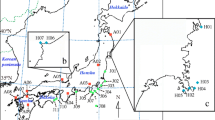Abstract
Apomixis and hybridization together contribute to taxonomic complexity inAmelanchier. Hybridization combines genetically divergent genomes and spawns new forms that apomixis perpetuates. Apomixis is aposporous, facultative, and pseudogamous in the genus, and apomicts are generally polyploid, pollen fertile, and pollinated by generalists. That gene flow actually occurs is empirically evident. As apomixis is genetically dominant over sexuality, hybrids involving at least one apomictic parent are apomictic. Clonal reproduction may thus perpetuate F1 individuals and generate agamospecies. Alternatively hybrids may interbreed and backcross to create hybrid swarms or cross with species other than the parents. In eastern North America, the abundance of published names and general taxonomic confusion in the genus doubtless result at least in part from this interplay of apomixis and hybridization. The roles of apomixis and hybridization in diversification withinAmelanchier are examined in light of new data about breeding system of an apomictic, hybrid microspecies, informally namedA. “erecta” and its formation of a hybrid swarm with anotherAmelanchier apomict,A. laevis.
Similar content being viewed by others
References
Arnold M.L., Backner C.M. &Robinson J.J. (1991): Pollen-mediated introgression and hybrid speciation in Louisiana irises.Proc. Natl. Acad. Sci. U.S.A. 88: 1348–1402.
Asker S.E. &Jerling L. (1992):Apomixis in plants, CRC Press, Boca Raton.
Bayer R.J. (1987): Evolution and phylogenetic relationships of theAntennaria (Asteraceae: Inuleae) polyploid agamic complexes.Biol. Zentralbl. 106: 683–698.
Campbell C.S., Greene C.W., Neubauer B.F. &Higgins J.M. (1985): Apomixis inAmelanchier laevis, shadbush (Rosaceae, Maloidaeae).Amer. J. Bot. 72: 1397–1403.
Campbell C.S., Greene C.W. &Bergquist S.E. (1987): Apomixis and sexuality in three species ofAmelanchier, shadbush (Rosaceae: Maloideae).Amer. J. Bot. 74: 321–328.
Campbell C.S., Greene C.W. &Dickinson T.A. (1991): Reproductive biology in theMaloideae (Rosaceae).Syst. Bot. 16: 333–349.
Cinq-Mars L. (1971): Le genreAmelanchier au Québec.Naturaliste Canad. 98: 329–346.
Cruise J.E. (1964): Studies of natural hybrids inAmelanchier.Canad. J. Bot. 42: 651–663.
Czapik R. (1994): How to detect apomixis inAngiospermae.Polish Bot. Stud. 8: 13–21.
Dibble A.C. (1995):Conservation biology of shadbush, Amelanchier (Rosaceae):Evidence from systematics, population structure, and reproductive ecology. Ph.D. dissertation, University of Maine, Orono.
Dickinson T.A. (1986): Topodeme differentiation in Ontario taxa ofCrataegus (Rosaceae: Maloideae): Leaf morphometric evidence.Canad. J. Bot. 64: 2738–2747.
Dickinson T.A. &Campbell C.S. (1991): Population structure and reproductive ecology in theMaloideae (Rosaceae).Syst. Bot. 16: 349–360.
Dickinson T.A. &Phipps J.B. (1985): Studies inCrataegus L. (Rosaceae: Maloideae). XIII. Degree and pattern of phenotypic variation inCrataegus sect.Crus-galli in Ontario.Syst. Bot. 10: 322–337.
Favarger C. &Correvon P. (1967): Mise en évidence de “races chromosomiques” chez l'Amélanchier.Trav. Inst. Bot. Univ. Neuchâtel 14: 215–218.
Fernald M.L. (1950):Gray's manual of botany. American Book Co., New York.
Grant V. (1981):Plant speciation. Columbia University Press, New York.
Gustafsson Å. (1946–1947): Apomixis in higher plants.Acta Univ. Lund. N.S., Sect. 2. 42–43: 1–370.
Herr J.M., Jr. (1971): A new clearing-squash technique for the study of ovule development in angiosperms.Amer. J. Bot. 58: 785–790.
Hinds H.R. (1986):Flora of New Brunswick. Primrose Press, Fredericton.
Jones G.N. (1946):American species of Amelanchier. Urbana.
Kellogg B.A. (1990): Variation and species limits in agamospermous grasses.Syst. Bot. 15: 112–123.
Kirschner J. &Ŝtêpánek J. (1994): Clonality as a part of the evolution precess inTaraxacum.Folia Geobot. Phytotax. 29: 265–275.
Lalonde L.-M. (1957): A newAmelanchier of eastern Canada.Rhodora 59: 119–122.
Landry P. (1975). Le concept d'espèce et la taxinomie du genreAmelanchier (Rosacées).Bull. Soc. Bot. France 122: 243–252.
Marshall D.R. &Weir B.S. (1979): Maintenance of genetic variation in apomictic plant populations. I. Single locus models.Heredity 42: 159–172.
Nielsen E.L. (1939): A taxonomic study of the genusAmelanchier in Minnesota.Amer. Midl. Naturalist 22: 160–208.
Nogler G.A. (1984): Gametophytic apomixis. In:Johri B.M. (ed.),Embryology of the Angiosperms, Springer-Verlag, Berlin, pp. 475–518.
Phipps J.B., Robertson K.R., Smith P.G. &Rohrer J.R. (1990): A checklist of the subfamilyMaloideae (Rosaceae).Canad. J. Bot. 68: 2209–2269.
Richards A.J. (1986):Plant breeding systems. George Allen & Unwin, London.
Rieseberg L.H. (1995): The role of hybridization in evolution: Old wine in new skins.Amer. J. Bot. 82: 944–953.
Rieseberg L.H. &Wendel J.F. (1993): Introgression and its consequences. In:Harrison R.G. (ed.),Hybrid zones and the evolutionary process, Oxford University Press, New York, pp. 70–109.
Robinson W.A. (1982): Experimental taxonomy in the genusAmelanchier. II. Do the taxa inAmelanchier form an agamic complex?Rhodora 84: 85–100.
Rohlf F.J. (1993):NTSYS-pc. Numerical taxonomy and multivariate analysis system. Exeter Software, Setauket.
Roland A.E. &Smith E.C. (1969):The flora of Nova Scotia. The Nova Scotia Department of Education, Halifax.
SAS Institute, Inc. (1990):Statistical analysis system. SAS Institute, Cary.
Stebbins G.L. (1950):Variation and evolution in plants, Columbia University Press, New York.
Voss E.G. (1985):Michigan Flora. Part II. Dicots. Cranbrook Inst. Science Bull. 59 and University of Michigan Herbarium, Ann Arbor.
Weber J.E. &Campbell C.S. (1989): Breeding system of a hybrid between a sexual and an apomictic species ofAmelanchier, shadbush (rosaceae, Maloideae).Amer. J. Bot. 73: 341–347.
Wiegand K.M. (1912): The genusAmelanchier in eastern North America.Rhodora 14: 117–161.
Author information
Authors and Affiliations
Rights and permissions
About this article
Cite this article
Campbell, C.S., Wright, W.A. Apomixis, hybridization, and taxonomic complexity in eastern north AmericanAmelanchier (Rosaceae) . Folia Geobot 31, 345–354 (1996). https://doi.org/10.1007/BF02815379
Issue Date:
DOI: https://doi.org/10.1007/BF02815379




